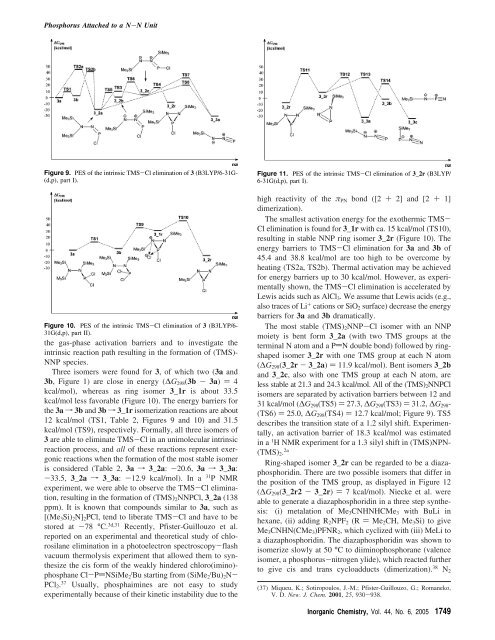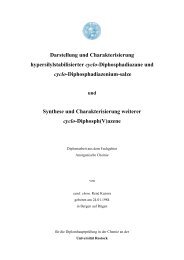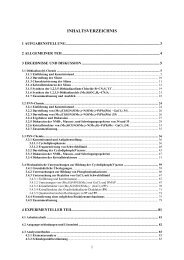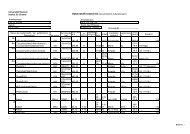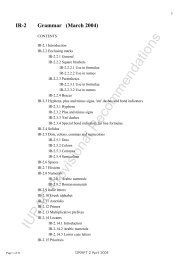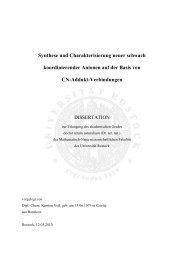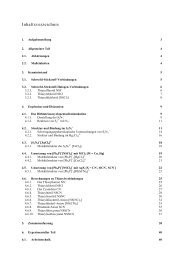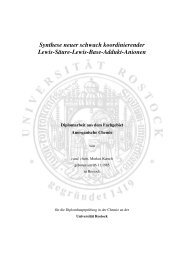Darstellung und Charakterisierung neuer niedrigkoordinierter ...
Darstellung und Charakterisierung neuer niedrigkoordinierter ...
Darstellung und Charakterisierung neuer niedrigkoordinierter ...
Create successful ePaper yourself
Turn your PDF publications into a flip-book with our unique Google optimized e-Paper software.
Phosphorus Attached to a N-N Unit<br />
Figure 9. PES of the intrinsic TMS-Cl elimination of 3 (B3LYP/6-31G-<br />
(d,p), part I).<br />
the gas-phase activation barriers and to investigate the<br />
intrinsic reaction path resulting in the formation of (TMS)-<br />
NNP species.<br />
Three isomers were fo<strong>und</strong> for 3, of which two (3a and<br />
3b, Figure 1) are close in energy (∆G298(3b - 3a) ) 4<br />
kcal/mol), whereas as ring isomer 3_1r is about 33.5<br />
kcal/mol less favorable (Figure 10). The energy barriers for<br />
the 3af3b and 3bf3_1r isomerization reactions are about<br />
12 kcal/mol (TS1, Table 2, Figures 9 and 10) and 31.5<br />
kcal/mol (TS9), respectively. Formally, all three isomers of<br />
3 are able to eliminate TMS-Cl in an unimolecular intrinsic<br />
reaction process, and all of these reactions represent exergonic<br />
reactions when the formation of the most stable isomer<br />
is considered (Table 2, 3af3_2a: -20.6, 3af3_3a:<br />
-33.5, 3_2a f 3_3a: -12.9 kcal/mol). In a 31P NMR<br />
experiment, we were able to observe the TMS-Cl elimination,<br />
resulting in the formation of (TMS)2NNPCl, 3_2a (138<br />
ppm). It is known that compo<strong>und</strong>s similar to 3a, such as<br />
[(Me3Si)2N]2PCl, tend to liberate TMS-Cl and have to be<br />
stored at -78 °C. 3d,31 Recently, Pfister-Guillouzo et al.<br />
reported on an experimental and theoretical study of chlorosilane<br />
elimination in a photoelectron spectroscopy-flash<br />
vacuum thermolysis experiment that allowed them to synthesize<br />
the cis form of the weakly hindered chloro(imino)phosphane<br />
Cl-PdNSiMe2 tBu starting from (SiMe2 tBu)2N- PCl2. 37 Figure 10. PES of the intrinsic TMS-Cl elimination of 3 (B3LYP/6-<br />
31G(d,p), part II).<br />
Usually, phosphaimines are not easy to study<br />
experimentally because of their kinetic instability due to the<br />
Figure 11. PES of the intrinsic TMS-Cl elimination of 3_2r (B3LYP/<br />
6-31G(d,p), part I).<br />
high reactivity of the πPN bond ([2 + 2] and [2 + 1]<br />
dimerization).<br />
The smallest activation energy for the exothermic TMS-<br />
Cl elimination is fo<strong>und</strong> for 3_1r with ca. 15 kcal/mol (TS10),<br />
resulting in stable NNP ring isomer 3_2r (Figure 10). The<br />
energy barriers to TMS-Cl elimination for 3a and 3b of<br />
45.4 and 38.8 kcal/mol are too high to be overcome by<br />
heating (TS2a, TS2b). Thermal activation may be achieved<br />
for energy barriers up to 30 kcal/mol. However, as experimentally<br />
shown, the TMS-Cl elimination is accelerated by<br />
Lewis acids such as AlCl3. We assume that Lewis acids (e.g.,<br />
also traces of Li + cations or SiO2 surface) decrease the energy<br />
barriers for 3a and 3b dramatically.<br />
The most stable (TMS)2NNP-Cl isomer with an NNP<br />
moiety is bent form 3_2a (with two TMS groups at the<br />
terminal N atom and a PdN double bond) followed by ringshaped<br />
isomer 3_2r with one TMS group at each N atom<br />
(∆G298(3_2r - 3_2a) ) 11.9 kcal/mol). Bent isomers 3_2b<br />
and 3_2c, also with one TMS group at each N atom, are<br />
less stable at 21.3 and 24.3 kcal/mol. All of the (TMS)2NNPCl<br />
isomers are separated by activation barriers between 12 and<br />
31 kcal/mol (∆G298(TS5))27.3, ∆G298(TS3))31.2, ∆G298-<br />
(TS6) ) 25.0, ∆G298(TS4) ) 12.7 kcal/mol; Figure 9). TS5<br />
describes the transition state of a 1.2 silyl shift. Experimentally,<br />
an activation barrier of 18.3 kcal/mol was estimated<br />
in a 1 H NMR experiment for a 1.3 silyl shift in (TMS)NPN-<br />
(TMS)2. 2a<br />
Ring-shaped isomer 3_2r can be regarded to be a diazaphosphoridin.<br />
There are two possible isomers that differ in<br />
the position of the TMS group, as displayed in Figure 12<br />
(∆G298(3_2r2 - 3_2r) ) 7 kcal/mol). Niecke et al. were<br />
able to generate a diazaphosphoridin in a three step synthesis:<br />
(i) metalation of Me3CNHNHCMe3 with BuLi in<br />
hexane, (ii) adding R2NPF2 (R ) Me2CH, Me3Si) to give<br />
Me3CNHN(CMe3)PFNR2, which cyclized with (iii) MeLi to<br />
a diazaphosphoridin. The diazaphosphoridin was shown to<br />
isomerize slowly at 50 °C to diiminophosphorane (valence<br />
isomer, a phosphorus-nitrogen ylide), which reacted further<br />
to give cis and trans cycloadducts (dimerization). 38 N2<br />
(37) Miqueu, K.; Sotiropoulos, J.-M.; Pfister-Guillouzo, G.; Romaneko,<br />
V. D. New. J. Chem. 2001, 25, 930-938.<br />
Inorganic Chemistry, Vol. 44, No. 6, 2005 1749


